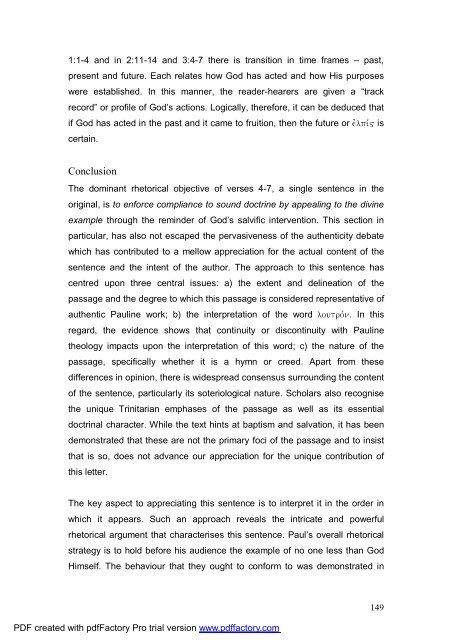A Text centred rhetorical analysis of Paul's Letter to Titus
A Text centred rhetorical analysis of Paul's Letter to Titus
A Text centred rhetorical analysis of Paul's Letter to Titus
You also want an ePaper? Increase the reach of your titles
YUMPU automatically turns print PDFs into web optimized ePapers that Google loves.
1:1-4 and in 2:11-14 and 3:4-7 there is transition in time frames – past,<br />
present and future. Each relates how God has acted and how His purposes<br />
were established. In this manner, the reader-hearers are given a “track<br />
record” or pr<strong>of</strong>ile <strong>of</strong> God’s actions. Logically, therefore, it can be deduced that<br />
if God has acted in the past and it came <strong>to</strong> fruition, then the future or ejlpiv~ is<br />
certain.<br />
Conclusion<br />
The dominant <strong>rhe<strong>to</strong>rical</strong> objective <strong>of</strong> verses 4-7, a single sentence in the<br />
original, is <strong>to</strong> enforce compliance <strong>to</strong> sound doctrine by appealing <strong>to</strong> the divine<br />
example through the reminder <strong>of</strong> God’s salvific intervention. This section in<br />
particular, has also not escaped the pervasiveness <strong>of</strong> the authenticity debate<br />
which has contributed <strong>to</strong> a mellow appreciation for the actual content <strong>of</strong> the<br />
sentence and the intent <strong>of</strong> the author. The approach <strong>to</strong> this sentence has<br />
<strong>centred</strong> upon three central issues: a) the extent and delineation <strong>of</strong> the<br />
passage and the degree <strong>to</strong> which this passage is considered representative <strong>of</strong><br />
authentic Pauline work; b) the interpretation <strong>of</strong> the word loutrovn. In this<br />
regard, the evidence shows that continuity or discontinuity with Pauline<br />
theology impacts upon the interpretation <strong>of</strong> this word; c) the nature <strong>of</strong> the<br />
passage, specifically whether it is a hymn or creed. Apart from these<br />
differences in opinion, there is widespread consensus surrounding the content<br />
<strong>of</strong> the sentence, particularly its soteriological nature. Scholars also recognise<br />
the unique Trinitarian emphases <strong>of</strong> the passage as well as its essential<br />
doctrinal character. While the text hints at baptism and salvation, it has been<br />
demonstrated that these are not the primary foci <strong>of</strong> the passage and <strong>to</strong> insist<br />
that is so, does not advance our appreciation for the unique contribution <strong>of</strong><br />
this letter.<br />
The key aspect <strong>to</strong> appreciating this sentence is <strong>to</strong> interpret it in the order in<br />
which it appears. Such an approach reveals the intricate and powerful<br />
<strong>rhe<strong>to</strong>rical</strong> argument that characterises this sentence. Paul’s overall <strong>rhe<strong>to</strong>rical</strong><br />
strategy is <strong>to</strong> hold before his audience the example <strong>of</strong> no one less than God<br />
Himself. The behaviour that they ought <strong>to</strong> conform <strong>to</strong> was demonstrated in<br />
PDF created with pdfFac<strong>to</strong>ry Pro trial version www.pdffac<strong>to</strong>ry.com<br />
149

















